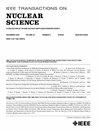A 32-Channel High-Speed High-Spatial-Resolution Front-End ASIC Prototype for the High Current Intensity Beam Positioning Detector
IF 1.9
3区 工程技术
Q3 ENGINEERING, ELECTRICAL & ELECTRONIC
引用次数: 0
Abstract
This article presents the design and test results of a high speed and high spatial resolution front-end application-specific integrated circuit (ASIC) prototype for the high current intensity beam positioning detector. An ionization chamber is proposed as the beam position detector. For these applications, ionization chambers are normally used, but to improve spatial resolution, we propose to integrate charge collection electrodes (CCEs) in the front-end ASIC prototype. The proposed ASIC prototype has been designed and manufactured in a32通道高速高空间分辨率高电流强光束定位检测器前端ASIC原型
本文介绍了一种高速、高空间分辨率的高电流强光束定位探测器前端专用集成电路(ASIC)样机的设计和测试结果。提出了一个电离室作为光束位置检测器。对于这些应用,通常使用电离室,但为了提高空间分辨率,我们建议在前端ASIC原型中集成电荷收集电极(CCEs)。所提出的ASIC原型已在0.18~\mu $ m的CMOS工艺中设计和制造。它具有32个通道,间距为$50~\mu $ m。每个通道由1厘米长的CCE,模拟前端(AFE),模拟缓冲器和移位寄存器组成。测试结果表明,该AFE的成形时间小于200 ns,在1.8 V电源下的功耗约为473~\mu $ W,等效噪声电荷(ENC)小于180 ${\ mathm {e}}^{-}$。
本文章由计算机程序翻译,如有差异,请以英文原文为准。
求助全文
约1分钟内获得全文
求助全文
来源期刊

IEEE Transactions on Nuclear Science
工程技术-工程:电子与电气
CiteScore
3.70
自引率
27.80%
发文量
314
审稿时长
6.2 months
期刊介绍:
The IEEE Transactions on Nuclear Science is a publication of the IEEE Nuclear and Plasma Sciences Society. It is viewed as the primary source of technical information in many of the areas it covers. As judged by JCR impact factor, TNS consistently ranks in the top five journals in the category of Nuclear Science & Technology. It has one of the higher immediacy indices, indicating that the information it publishes is viewed as timely, and has a relatively long citation half-life, indicating that the published information also is viewed as valuable for a number of years.
The IEEE Transactions on Nuclear Science is published bimonthly. Its scope includes all aspects of the theory and application of nuclear science and engineering. It focuses on instrumentation for the detection and measurement of ionizing radiation; particle accelerators and their controls; nuclear medicine and its application; effects of radiation on materials, components, and systems; reactor instrumentation and controls; and measurement of radiation in space.
 求助内容:
求助内容: 应助结果提醒方式:
应助结果提醒方式:


